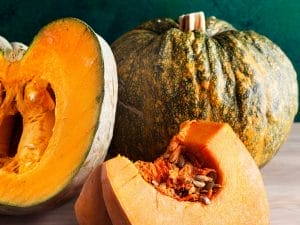Winter squashes includes several varieties of gourds that are harvested in the fall, but can be stored and eaten throughout the winter. They are a versatile ingredient that can be used in a wide range of savory and sweet recipes.
Unlike summer squashes, winter squashes mature fully on the vine resulting in a hard, thick skin, as well as an extended shelf life.
Save this guide to learn about the different winter squash available.
BUTTERNUT SQUASH –
Butternut squash is typically pear-shaped with a smooth, tan-colored skin and a bulbous end that contains the seeds. The flesh is vibrant orange. Butternut squash has a sweet and slightly nutty flavor, making it a versatile ingredient in both savory and sweet dishes.
ACORN SQUASH –
Acorn squash is small, typically about the size of a large acorn, hence its name. It has a hard, ribbed, dark green or orange skin. The flesh is yellow-orange.Acorn squash has a mild, slightly sweet, and nutty flavor. The flavor is milder compared to butternut squash. Acorn squash can be roasted, baked, steamed, or microwaved. It’s commonly halved or quartered, and the seeds and stringy flesh are removed before cooking.
KABOCHA-
Kabocha, also known as Japanese pumpkin or Japanese squash, is a type of winter squash that is popular in many Asian cuisines. Kabocha squash is typically small to medium-sized, round or squat, with a deep green or orange skin. The skin can be smooth or slightly bumpy with a dense, tender-textured interior. The flesh has a sweet, nutty and rich flavour. It’s often described as having a flavour profile somewhere between a sweet potato and a pumpkin.
DELICATA –
Delicata squash is small to medium-sized with an elongated, cylindrical shape. It has cream-colored, pale yellow or green skin with distinctive dark green, striped markings. Unlike many other winter squashes, delicata squash has edible skin. Delicata squash is known for its sweet, nutty flavour and tender, creamy flesh. Its flavor is often compared to sweet potatoes. This squash is easy to prepare and cook. Because the skin is edible, it’s easy to slice into rounds. It can be roasted, baked, or grilled. Its smaller size and thin skin make the cook time quicker compared to larger winter squashes.
PUMPKIN-
Pumpkins come in various shapes and sizes, but they are typically round to oblong with a ribbed, thick, and usually orange or yellowish skin. The flesh inside is typically orange or yellow and can range from fibrous to smooth, depending on the specific variety. Pumpkin has a mildly sweet, earthy, and nutty flavor. It can be used in both sweet and savoury dishes. Pumpkin seeds, known as pepitas, are a good source of protein and healthy fats. They can be easily be seasoned and roasted in the oven!
SPAGHETTI SQUASH-
Spaghetti squash is oval or oblong in shape and typically has a yellow or ivory-colored skin. When you cut it open and cook it, the flesh turns into long, stringy strands, resembling spaghetti. It is often substituted as a gluten free “pasta” noodle in dishes. Spaghetti squash has a mild, slightly sweet flavour.
CARNIVAL SQUASH-
Carnival squash is a relatively small, oblong or bell-shaped squash with variegated patterns and colors on its skin. It typically has a mottled combination of orange, green, yellow, and cream colors. The skin can be quite hard. Carnival squash has a mild and slightly sweet flavour. Its taste is often described as a cross between acorn squash and sweet potato.
HUBBARD –
Hubbard squash is a type of winter squash known for its large size, bumpy and irregular skin. Its colouring can range from dark green to blue-grey or even orange! Hubbard’s have a dense flesh with a sweet, rich and nutty flavour. These large gourds can weigh anywhere from 8 to 20 pounds!
BANANA SQUASH-
Banana squash, also known as Cucurbita maxima, is a type of winter squash that resembles a large, elongated banana in shape. It is one of the largest winter squash varieties and can grow up to two feet in length! It typically has pale orange to tan skin with a sweet and mildly nutty flavour, which becomes more pronounced as it matures.













